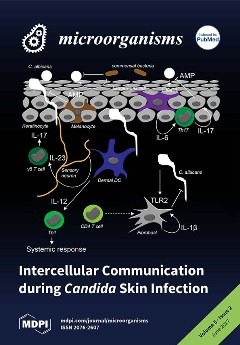Analysis of 49 strains of
Fusarium langsethiae originating from northern Europe (Russia, Finland, Sweden, UK, Norway, and Latvia) revealed the presence of spontaneous auxotrophic mutants that reflect natural intraspecific diversity. Our investigations detected that 49.0% of
F. langsethiae strains were auxotrophic mutants for
[...] Read more.
Analysis of 49 strains of
Fusarium langsethiae originating from northern Europe (Russia, Finland, Sweden, UK, Norway, and Latvia) revealed the presence of spontaneous auxotrophic mutants that reflect natural intraspecific diversity. Our investigations detected that 49.0% of
F. langsethiae strains were auxotrophic mutants for biotin, and 8.2% of the strains required thiamine as a growth factor. They failed to grow on vitamin-free media. For both prototrophic and auxotrophic strains, no growth defect was observed in rich organic media. Without essential vitamins, a significant reduction in the growth of the auxotrophic strains results in a decrease of the formation of T-2 toxin and diacetoxyscirpenol. In addition, all analysed
F. langsethiae strains were distinguished into two subgroups based on PCR product sizes. According to our results, 26 and 23 strains of
F. langsethiae belong to subgroups I and II respectively. We determined that the deletion in the intergenic spacer (IGS) region of the rDNA of
F. langsethiae belonging to subgroup II is linked with temperature sensitivity and causes a decrease in strain growth at 30 °C. Four thiamine auxotrophic strains were found in subgroup I, while 21 biotin auxotrophic strains were detected in subgroups II. To the best of our knowledge, the spontaneous mutations in
F. langsethiae observed in the present work have not been previously reported.
Full article






